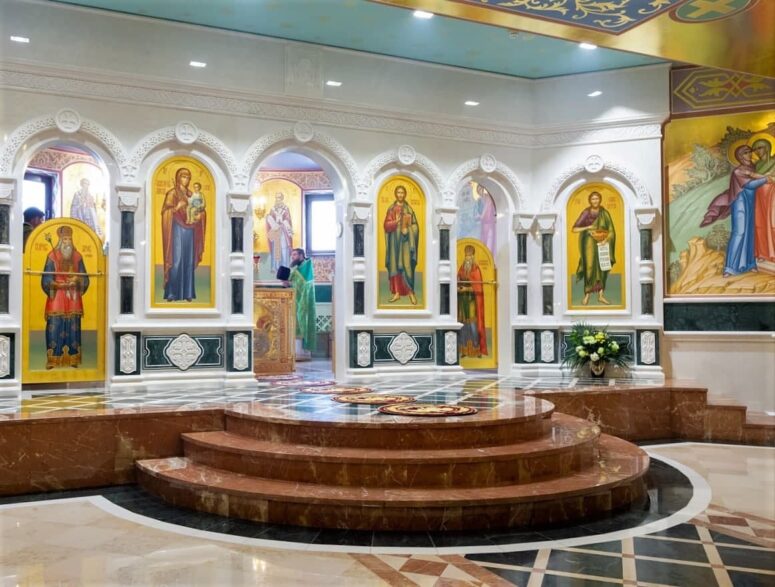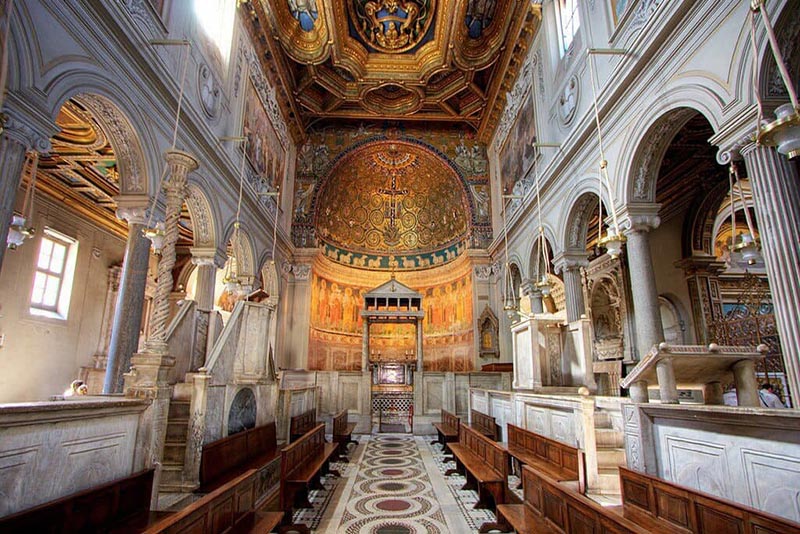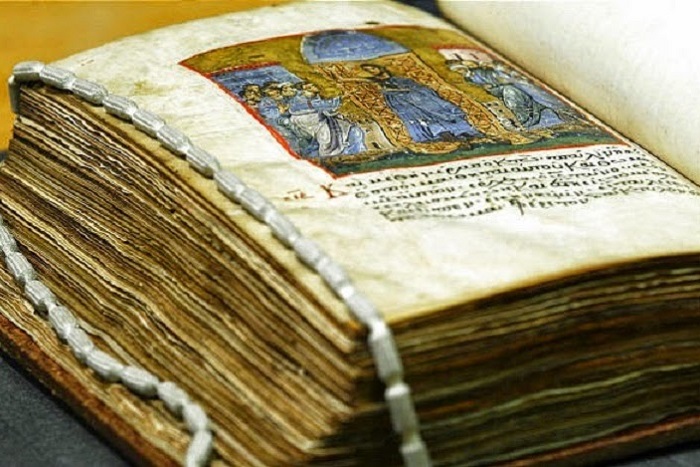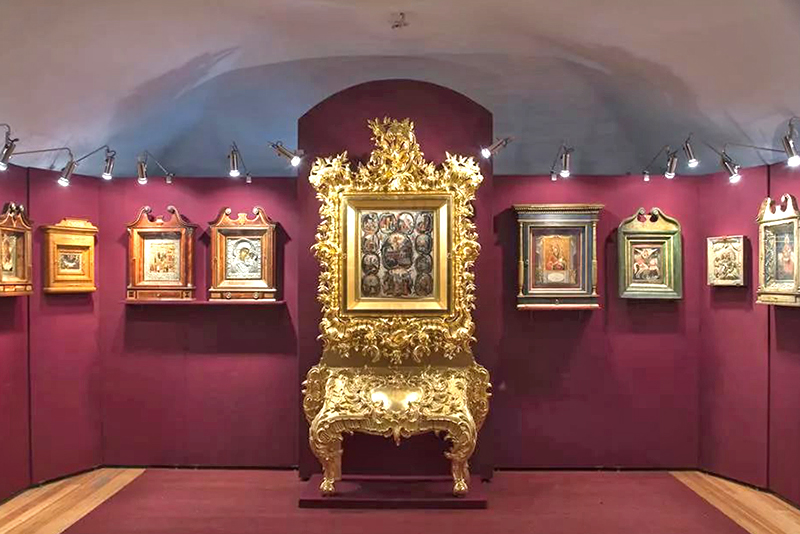
The most solemn moments of Matins, such as polyeleos, parastas and the lamentations (during the Holy Saturday and the Dormition of the Theotokos services) are distinguished by the clerics leaving the altar and standing in the central nave, amidst the congregation. In many parishes and monasteries of the Russian church the clergymen precede the beginning of the polyeleos with spreading carpets in the center of the church, emphasizing the importance and solemnity of the moment. In some of the most ancient churches one can still observe a separate space used by clerics and enclosed with a distinctive lattice. That space is called the bema. What are the factors that have caused that custom to appear? What ancient temple elements does the polyeleos carpet refer us to? What does the word bema mean?
The Bema
In early Christian churches, any elevation above the floor was called a bema (Greek Βῆμα – step, elevation). The word is repeatedly used in the New Testament texts in its customary meaning of that time, i. e. “a judicial tribune” or “a court”, since the courts were held on distinct elevated platforms. In church architecture, a designated platform rising above the rest of the floor was usually located in the altar part of the temple, but not always and not everywhere. In Syrian churches, for example, bema was often found in the center of the temple. The Syrian bema is an analogue of the Byzantine synthronon, i.e. the Bishop’s Throne with adjacent places for the clergy. In contrast with the Byzantine tradition of placing the synthronon in the altar apse, the Syrian bema was located in the center of the temple and looked like a kind of an amphitheater in the middle of the naos (the central nave). The seats at the upper step of the bema were to be occupied by the clergy, with the bishop in the middle. The bema is still the place where the liturgy of the catechumens takes place in the Eastern Church (Taft. 1968), while the clergy only enter the altar when the liturgy of the faithful begins. In today’s Orthodox Church, the bema is mainly represented by the altar elevation, including the altar, the iconostasis and the space in front of the iconostasis consisting of the solea and the ambon and separated from the temple by 2 or 3 steps.
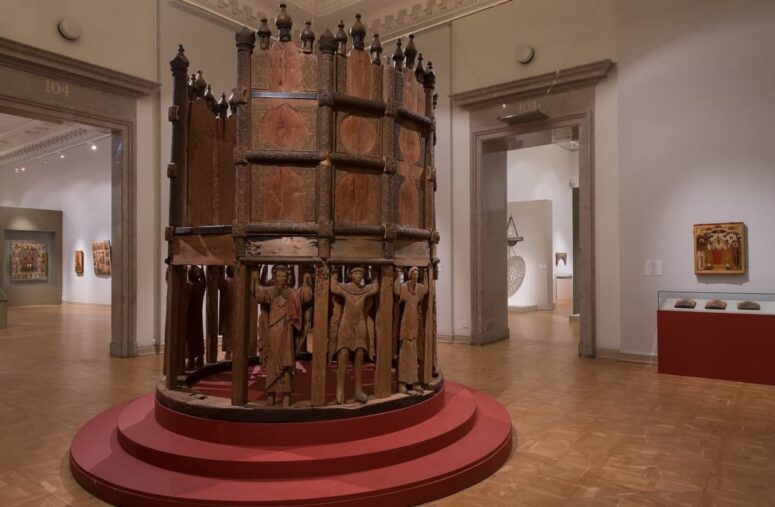
Today many key parts of the divine service, such as the Scripture readings during festive matins or a bishop’s liturgy, anointing with oil, the rites of the Exaltation of the Cross, the Triumph of Orthodoxy and some others, are celebrated by the clergy in the center of the church. This tradition dates back to the ancient times when all these worship elements took place at the bema, also called the ambon. The ancient ambon looked completely different and was located not in front of the altar, but in the center of the temple.
Ambon
Greek. Ἄμβων – “elevation”, was a separate, rather high structure in the center of the naos, used by the clergy to read the Scriptures, deliver sermons and sing certain hymns. Sozomen, the church historian of the 5th century, mentions the ambon, referring to it as the “bema” or the “elevation for the readers”. The use of the ambon is noted in Canon 15 of the Laodicean Council (mid 6th century). Initially, the ambon was arranged in the form of a portable platform with steps and an analogion. However, in the 5th-6th centuries it began to turn into a stationary structure of a cylindrical or round shape. As was the case in churches of Constantinople, the ambo was adjoined by stairs on two sides, whereas its middle part was raised on columns. Such ambons were richly decorated with sculptures, mosaics and marble carvings. A solea, fenced with lattice on both sides, connected the ambo with the altar.
The Byzantine poet Paul the Silentiary in his description of St Sofia church indicates that the ambon, created by Justinian exclusively for the main temple of Byzantium, was embowered with a ciborium resting on eight columns and crowned with a cross. That testifies to the important role of the ambon, comparable to one of the altar, which was also usually draped with a ciborium. We can say that churches used to have two holy elevations around which divine services evolved. The ambo was the center, around which the Liturgy of the Word was celebrated, whereas the altar was the place for the Eucharist. Some ambons made after the 15th century had the form of a gazebo or a balcony, suspended from a temple’s column.
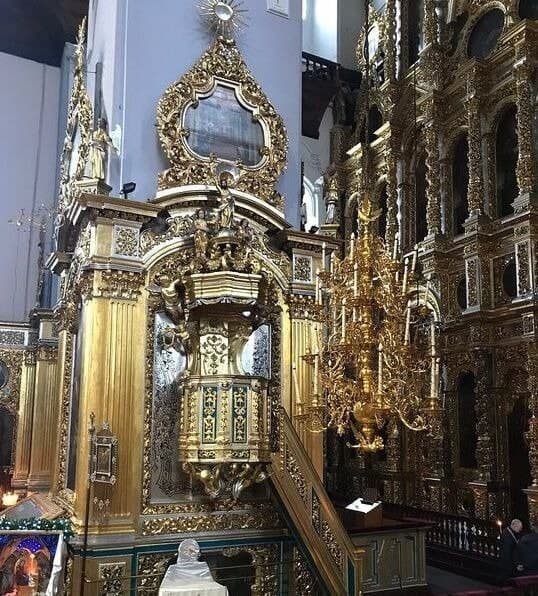
In medieval Russia there was also a tradition to construct ambons in the form of a tower with stairs in the middle of the temple or in the form of a balcony on a column. Such ambons existed in cathedral churches of the largest Russian cities until the 17th century, when they gradually fell out of use. From the 17th century the tradition of referring to the protrusion in the center of the solea as the ambon appeared in the Russian church. The bishop’s pulpit or the “vesting place”, sometimes erroneously referred to as the cathedra, also descends from the ancient ambon platform.
Thus, the ambon or bema in the center of the Byzantine temple, together with the altar, were the main architectural structures that not only organized the liturgical space of the church, but also influenced the emergence of many specific features of the Byzantine rite. Typicon of St. Sofia, the Service Book of St. Sophia Cathedral in Novgorod and other sources give a detailed description of the ancient ambon’s role in worship service. It served as the place for singing the antiphons of the Liturgy, proclaiming the Trisagion, Prokimena and Alleluia Verses as well as reading the Gospel and the most important holiday hymns. The place between the lower step of the ancient ambon and the congregation was also used for reading the Prayer behind the Ambo, which served as the dismissal for the faithful. At present, the functions of the Byzantine ambon have largely shifted to the modern Solea, however, the memory of the importance of the ambon / bema in the center of the naos is still preserved in the church consciousness, which is expressed in the desire to uniquely decorate or otherwise highlight this place in worship.
